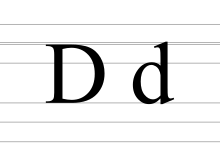|
D
D, or d, is the fourth letter of the Latin alphabet, used in the modern English alphabet, the alphabets of other western European languages and others worldwide. Its name in English is dee (pronounced /ˈdiː/), plural dees.[1] History
The Semitic letter Dāleth may have developed from the logogram for a fish or a door.[2] There are many different Egyptian hieroglyphs that might have inspired this. In Semitic, Ancient Greek[3] and Latin,[4] the letter represented /d/; in the Etruscan alphabet[5] the letter was archaic but still retained. The equivalent Greek letter is delta, Δ.[3] The minuscule (lower-case) form of 'd' consists of a lower-story left bowl and a stem ascender. It most likely developed by gradual variations on the majuscule (capital) form 'D', and is now composed as a stem with a full lobe to the right. In handwriting, it was common to start the arc to the left of the vertical stroke, resulting in a serif at the top of the arc. This serif was extended while the rest of the letter was reduced, resulting in an angled stroke and loop. The angled stroke slowly developed into a vertical stroke.[6] Use in writing systems
EnglishIn English, ⟨d⟩ generally represents the voiced alveolar plosive /d/. The letter ⟨d⟩ is the tenth most frequently used in the English language. Other languages In most languages that use the Latin alphabet, ⟨d⟩ generally represents the voiced alveolar or voiced dental plosive /d/. In the Vietnamese alphabet, it represents the sound /z/ in northern dialects or /j/ in southern dialects. In Fijian, it represents a prenasalized stop /ⁿd/.[7] In some languages where voiceless unaspirated stops contrast with voiceless aspirated stops, ⟨d⟩ represents an unaspirated /t/, while ⟨t⟩ represents an aspirated /tʰ/. Examples of such languages include Icelandic, Scottish Gaelic, Navajo and the pinyin transliteration of Mandarin. Other systemsIn the International Phonetic Alphabet, ⟨d⟩ represents the voiced alveolar plosive /d/. Other uses
Related charactersDescendants and related characters in the Latin alphabet
Ancestors and siblings in other alphabets
Derived signs, symbols and abbreviations
Other representationsComputingThe Latin letters ⟨D⟩ and ⟨d⟩ have Unicode encodings U+0044 D LATIN CAPITAL LETTER D and U+0064 d LATIN SMALL LETTER D. These are the same code points as those used in ASCII and ISO 8859. There are also precomposed character encodings for ⟨D⟩ and ⟨d⟩ with diacritics, for most of those listed above; the remainder are produced using combining diacritics. Variant forms of the letter have unique code points for specialist use: the alphanumeric symbols set in mathematics and science, plosive sounds in linguistics and halfwidth and fullwidth forms for legacy CJK font compatibility. Other
In British Sign Language (BSL), the letter 'd' is indicated by signing with the right hand held with the index and thumb extended and slightly curved, and the tip of the thumb and finger held against the extended index of the left hand. References
External linksWikimedia Commons has media related to D. Information related to D |
||||||||||||||||||||||||||||||||||||||||||||||||||||||||||||||||||||||||||||||||||||||||||||







